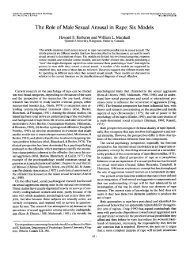Regulation of the dopamine transporter - Addiction Research ...
Regulation of the dopamine transporter - Addiction Research ...
Regulation of the dopamine transporter - Addiction Research ...
You also want an ePaper? Increase the reach of your titles
YUMPU automatically turns print PDFs into web optimized ePapers that Google loves.
Schmitt & Reith DAT <strong>Regulation</strong><br />
methamphetamine users typically take upward <strong>of</strong><br />
100 mg (a “point”) per dose session—for those<br />
that administer it via inhalation (as smoked “crystal<br />
meth” or “ice”), this can be even higher—<strong>of</strong>ten<br />
taking multiple subsequent doses in a “binge” pattern<br />
(every few hours); chronic methamphetamine<br />
addicts can easily consume doses on <strong>the</strong> order <strong>of</strong><br />
grams per day. 145 Intranasal administration <strong>of</strong> a 50mg<br />
dose <strong>of</strong> d-methamphetamine results in an average<br />
plasma concentration <strong>of</strong> 758 nM in human<br />
subjects. 148 Sequential 100-mg doses could thus result<br />
in prolonged plasma drug concentrations ranging<br />
into <strong>the</strong> micromolar levels shown in animal<br />
and in vitro studies to elicit pr<strong>of</strong>ound <strong>dopamine</strong><br />
release, cytotoxicity, and long-lasting downregulation<br />
<strong>of</strong> DAT function. Methamphetamine addicts<br />
that consume gram quantities per day can<br />
achieve steady-state plasma concentrations exceeding<br />
13 �M. 74 Hence, it is likely that <strong>the</strong> transient reduction<br />
in plasmalemmal DAT expression observed<br />
after a single high-level dose <strong>of</strong> methamphetamine<br />
and <strong>the</strong> prolonged reduction seen in chronic<br />
high-dose methamphetamine users are two entirely<br />
different phenomena: <strong>the</strong> former representing a<br />
neuroadaptive feedback mechanism and <strong>the</strong> latter<br />
representing accumulated apoptotic oxidative injury<br />
to <strong>dopamine</strong>rgic neurons.<br />
Conclusion<br />
Neuronal DATs are <strong>the</strong> primary regulators <strong>of</strong><br />
extracellular <strong>dopamine</strong> in <strong>the</strong> brain and are thus responsible<br />
for both <strong>the</strong> duration and <strong>the</strong> magnitude<br />
<strong>of</strong> interneuronal <strong>dopamine</strong>rgic signals. Biogenic<br />
amine <strong>transporter</strong> proteins, such as <strong>the</strong> DAT, are<br />
highly dynamic entities that rapidly cycle between<br />
<strong>the</strong> plasma membrane and early endosomal compartments,<br />
probably in specialized vesicles roughly<br />
similar to synaptic vesicles in size (e.g., Ref. 19). By<br />
altering <strong>the</strong> pattern <strong>of</strong> DAT trafficking, cells can adjust<br />
<strong>the</strong> number <strong>of</strong> active (surface localized) DATs<br />
in real time, allowing for condition-specific adaptive<br />
changes in <strong>dopamine</strong>rgic signaling. DAT trafficking<br />
is regulated by several intracellular signaling cascades<br />
involving protein kinases and phosphatases.<br />
Activation or inhibition <strong>of</strong> PKC, PI3K, and members<br />
<strong>of</strong> <strong>the</strong> MAPK family can trigger <strong>transporter</strong><br />
membrane redistribution; however, <strong>the</strong> identity <strong>of</strong><br />
<strong>the</strong> kinase(s) ultimately responsible for direct phosphorylation<br />
<strong>of</strong> <strong>the</strong> DAT is currently unknown. With<br />
<strong>the</strong> recent evidence that syntaxin 1A and o<strong>the</strong>r scaffolding<br />
proteins interact with <strong>the</strong> DAT, it is certainly<br />
conceivable that central signaling kinases, such as<br />
PKC, affect DAT activity via DAT-associated scaffolding<br />
or cytoskeletal proteins that more directly<br />
control <strong>the</strong> <strong>transporter</strong>’s trafficking fate. In addition,<br />
ligands for certain presynaptic GPCRs found<br />
on <strong>dopamine</strong>rgic neurons (such as <strong>dopamine</strong> D2like<br />
autoreceptors and �-opioid receptors) can also<br />
acutely regulate DAT surface presence, probably by<br />
modulating <strong>the</strong> activity <strong>of</strong> <strong>the</strong>se cell signal transduction<br />
pathways.<br />
Finally, DAT trafficking is acutely regulated by ligands<br />
that directly interact with <strong>the</strong> DAT itself (substrates<br />
and inhibitors). Acute exposure to high doses<br />
<strong>of</strong> substrates (including several amphetaminergic<br />
compounds and <strong>dopamine</strong> itself) elicits a biphasic<br />
effect on DAT trafficking: initially, a rapid yet<br />
transient (beginning within seconds and lasting for<br />
several minutes) increase in surface DAT occurs,<br />
followed by significant <strong>transporter</strong> endocytosis that<br />
begins after approximately 15 min <strong>of</strong> substrate exposure.<br />
In direct contrast with <strong>the</strong> internalizing effects<br />
<strong>of</strong> substrates, cocaine-like DAT inhibitors appear<br />
to induce upregulation <strong>of</strong> surface DAT levels. Upregulation<br />
<strong>of</strong> surface DAT concentration might be<br />
responsible for much <strong>of</strong> <strong>the</strong> anhedonic, depressionlike<br />
symptoms that chronic cocaine addicts experience<br />
during withdrawal—doubtless triggering<br />
cravings for more cocaine. The DAT-internalizing<br />
effect <strong>of</strong> substrates, such as d-amphetamine, might<br />
thus be useful in ameliorating symptoms <strong>of</strong> cocaine<br />
withdrawal. In limited preclinical trials,<br />
d-amphetamine has shown efficacy in reducing cocaine<br />
consumption and craving. 43 Amphetaminergic<br />
prodrugs would be desirable for this purpose,<br />
because <strong>the</strong>ir requisite metabolic activation after<br />
oral administration and slow onset <strong>of</strong> action would<br />
prevent <strong>the</strong> possibility <strong>of</strong> parenteral abuse, a clear<br />
concern in psychostimulant-addicted patients. The<br />
atypical psychostimulant compound modafinil also<br />
shows preclinical promise as a potential <strong>the</strong>rapeutic<br />
for stimulant addiction. Modafinil decreases cocaine<br />
craving during withdrawal 149 and attenuates<br />
<strong>the</strong> effect <strong>of</strong> concomitantly administered cocaine 150<br />
or methamphetamine, 151 warranting investigation<br />
into its effects on DAT trafficking. There is also evidence<br />
that withdrawal from psychostimulant use<br />
is associated with deficits in not only <strong>dopamine</strong>rgic<br />
but also serotonergic function. Moreover, agents<br />
Ann. N.Y. Acad. Sci. 1187 (2010) 316–340 c○ 2010 New York Academy <strong>of</strong> Sciences. 333










